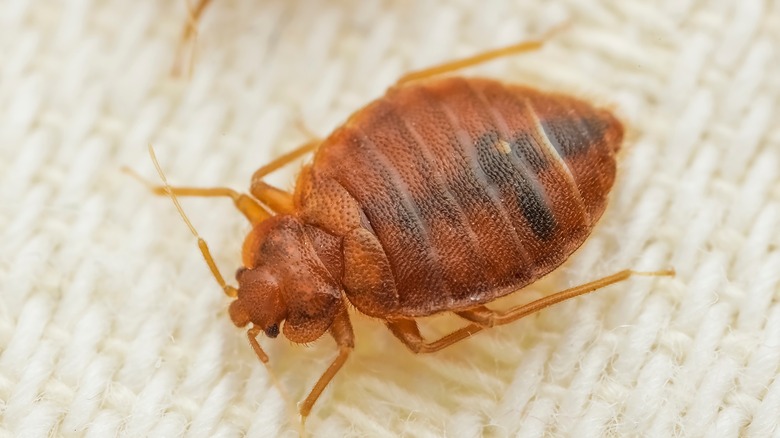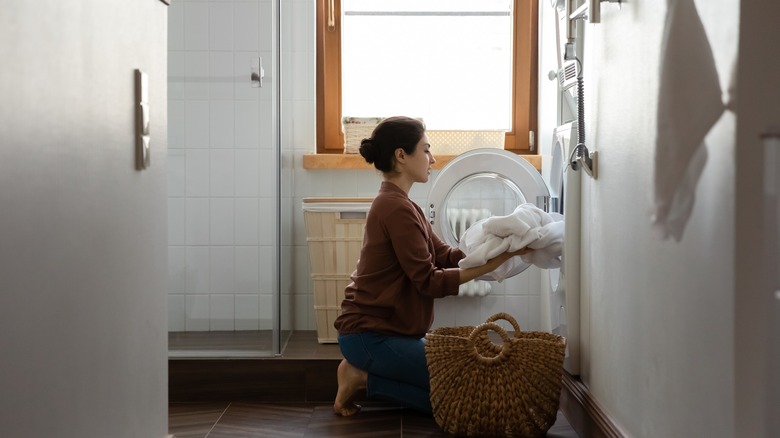Reach Into Your Pantry For All The Ingredients You Need To Trap Bed Bugs
Bed bugs are one of the most sinister home pests. Unfortunately, suspecting a bed bug infestation in your home is not enough; you'll need hard evidence — and no, those bug bites on your back aren't even enough. Bed bug bites can be mistaken for other parasite attacks, such as scabies. The first thing you need to do if you suspect bed bugs is to trap one. Since bed bugs are drawn to CO2 — the same gas that humans exhale — your trap will involve producing this with a combination of sugar and yeast.
Collect the following: sugar; yeast; water; a large, empty bucket (enough to hold at least 3 gallons); two divided plastic dog bowls; talcum powder; four wooden coffee coasters; and some surgical tape. Cover the exterior of the dog bowl in surgical tape, which will provide texture for the bugs to crawl up. Flip the bowls upside down, and you will see a trough-like area surrounding the raised portions — lightly coat the trough with talcum powder, which will make the surfaces too slippery for the bugs to escape. Combine 10 tablespoons of sugar, 2 tablespoons of yeast, and 1½ liters of warm water in the large bucket. Stir and wait for the yeast to bubble and rise. Put the lid back on, cracking it to allow CO2 fumes out. Next, place a coffee coaster on each of the center-raised portions of the dog bowls, and position the bucket on top of them. Leave the trap overnight or until you have trapped a few bugs.
So, you have bed bugs ... what next?
Once you've trapped the bugs, dispose of the liquid mixture down the toilet and wash the container after use if you plan to keep it; remember to keep children and pets away from the trap. Finally, take photos of any trapped bugs, and encase the dog bowls in gallon zipper storage bags to prevent any escapees. Professional exterminators should be able to address the issue quickly, though different approaches will impact the exact timeline and how much the extermination will cost.
While you wait for the experts to arrive, however, you can get to work: Strip all of the bedding in your room and launder it on high-heat settings for both the washer and dryer. Some sites may recommend trying to kill off bed bugs by encasing linens in black, plastic bags and placing them in the sunlight on a hot day; this, however, is likely not a reliable method of extermination. Also, although it can be easy — and understandable — to lose your cool upon uncovering an infestation, remember that bed bugs, while very gross, usually do not pose a serious health risk to humans. Handling the infestation quickly and calmly is the best approach.
Avoiding bed bugs to begin with
Nocturnal in nature, capable of burrowing deep within mattresses, and difficult to spot due to their size, these blood-sucking parasites can wreak havoc on a household for months before they are detected; but there are ways to mitigate the risk of a repeat infestation. If you enjoy buying second-hand furniture for DIY projects, remember to heat treat it with a handheld steamer to avoid inviting in unwanted guests.
Bed bugs are also master hitchhikers and can easily wind up in even the most pristine homes — one of the best ways to minimize the chances of a full-blown infestation is through regular cleaning and decluttering. Vacuuming carpeted floors and following with a high-heat carpet cleaner can be a wise choice, especially after hosting out-of-town guests. When you return home from a trip, keep your worn, dirty clothes in a sealed plastic bag until you are ready to wash and dry them, which will kill adult bed bugs or eggs if done with sufficient time and heat. Hard case luggage is also more difficult for bed bugs to stick to than soft-sided options; always inspect the exterior for bugs before bringing it back inside your home.


